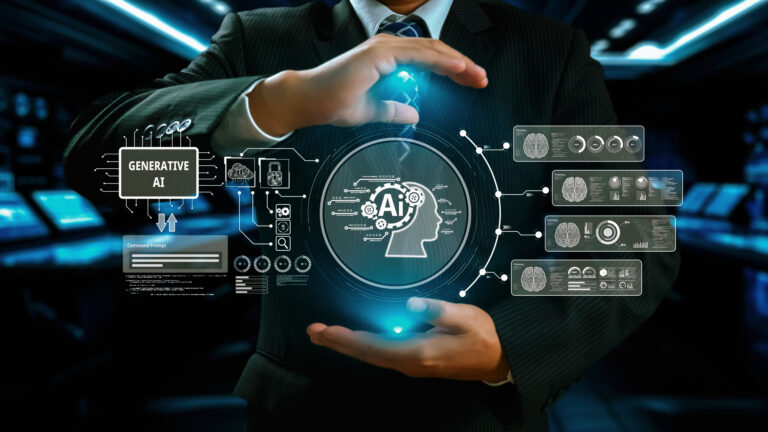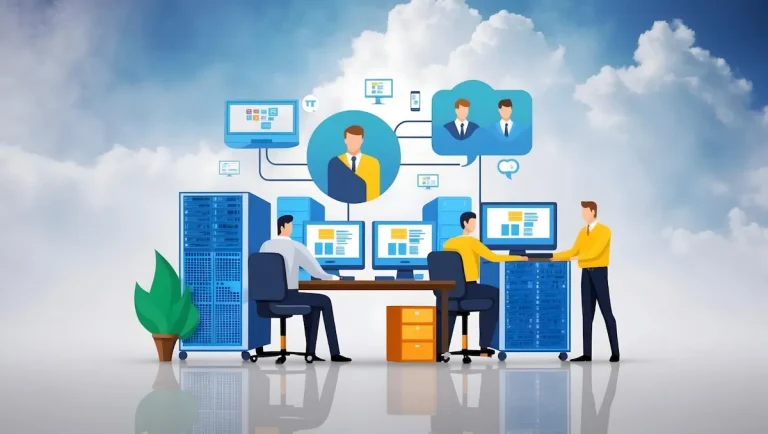Introduction
Legacy systems have long been the backbone of critical business functions. However, as technology evolves, these outdated platforms become bottlenecks—limiting agility, compromising security, and hindering compliance. For IT leaders, the imperative to modernize is no longer optional—it’s a business continuity requirement.
Today, the convergence of Artificial Intelligence (AI) and Managed Service Providers (MSPs) offers a compelling path forward. Together, they enable organizations to AI for legacy system modernization without interrupting business operations. AI simplifies analysis, automation, and optimization, while MSPs bring deep domain expertise, 24/7 support, and scalable IT infrastructure management.
This article unpacks how businesses can leverage AI and MSPs as strategic enablers in their modernization journey. We explore challenges, benefits, compliance requirements, and practical steps to help IT executives transition from outdated systems to resilient digital infrastructures that support growth, agility, and future readiness.
What Are Legacy Systems and Why Modernize Them?
Legacy systems are outdated IT environments that may still perform essential functions but cannot keep up with today’s dynamic digital requirements. Modernization addresses performance bottlenecks, security vulnerabilities, and high maintenance costs, while ensuring business agility.
- Inflexible systems can’t integrate with modern applications.
- Legacy tech often fails to meet compliance mandates.
- Maintenance is expensive and unsustainable.
- Data is often siloed and inaccessible.
- Vulnerabilities increase due to outdated code.
- Talent shortages plague legacy skillsets.
The Role of AI in Legacy System Modernization
AI acts as a modernization catalyst by automating code conversion, analyzing system dependencies, and predicting infrastructure failures. It accelerates modernization while reducing manual errors and cost.
- AI assesses legacy workload risks accurately.
- Accelerates data and application migration.
- Identifies redundant processes and improves workflows.
- Enables predictive maintenance of aging systems.
- Optimizes resource consumption in legacy environments.
- Supports intelligent decision-making through analytics.
MSPs as Strategic Enablers in Modernization
Managed Service Providers provide the technical muscle and strategic insight required to modernize legacy systems. They manage the migration, ensure compliance, and mitigate disruption risks.
- Offer phased migration plans and timelines.
- Manage hybrid cloud and legacy co-existence.
- Provide skilled IT resources with modernization expertise.
- Ensure business continuity during migration phases.
- Deliver cost-effective, SLA-bound transformation.
- Act as long-term partners for post-modernization support.
Integrating AI and MSPs: The Perfect Modernization Partnership
The synergy between AI and MSPs unlocks faster, safer, and smarter modernization. AI driven MSP provides the intelligence; MSPs provide the execution.
- AI identifies modernization priorities based on business goals.
- MSPs deploy AI models for decision-making.
- Automation reduces time-to-modernize and error rates.
- AI-powered dashboards improve system transparency.
- MSPs implement and train staff on AI tools.
- Seamless integration across legacy and cloud ecosystems.
Ensuring Compliance and Security with AI
Legacy systems often fall short on data privacy and industry compliance. AI-enabled MSPs strengthen compliance frameworks and improve security through continuous monitoring.
- AI scans for compliance gaps automatically.
- Supports HIPAA, PCI-DSS, GDPR, and other frameworks.
- Detects vulnerabilities before they are exploited.
- Maintains audit trails and logs changes.
- Flags non-compliant configurations in real-time.
- MSPs ensure secure deployment of AI modules.
Overcoming Common Challenges in Legacy System Modernization
Challenges include data integrity, system downtime, integration issues, and resistance to change. AI and MSPs tackle these challenges with speed and precision.
- AI forecasts data integrity risks early.
- MSPs design fallback systems to prevent downtime.
- AI validates integration readiness before execution.
- Offers sandbox environments for testing.
- Change management is streamlined via user training.
- MSPs provide 24/7 remediation support.
Key Benefits of AI and MSP Collaboration
AI and MSPs combined deliver business agility, scalability, security, and resilience—making modernization faster and more cost-efficient.
- Significant reduction in infrastructure TCO.
- Predictive analytics for smarter IT decisions.
- Real-time monitoring and alerts.
- Scalable modernization aligned with business growth.
- Reduced dependency on legacy vendors.
- Data-driven insights to improve ROI.
Future Trends in AI-Powered Modernization
The future includes self-healing infrastructure, low-code transformation tools, and AI reshaping for MSPs co-pilots managing modernization autonomously—with MSPs guiding strategy and compliance.
- Low-code tools for faster application modernization.
- AI co-pilots for infrastructure optimization.
- Zero-touch operations powered by AI.
- Cross-platform interoperability driven by intelligent APIs.
- Cloud-native AI models accelerating containerization.
- MSPs evolving into AI system integrators.
How Businesses Can Get Started with AI-Driven Modernization
A strategic roadmap, a trusted MSP partner, and AI-led assessment are key to successful legacy modernization.
- Conduct a system inventory and dependency audit.
- Define modernization objectives and budget.
- Choose MSPs experienced in legacy tech.
- Use AI to evaluate technical debt.
- Phase the migration to minimize disruption.
- Ensure ongoing performance benchmarks.
AI-Powered Risk Mitigation Strategies for Legacy Systems
AI helps proactively detect threats and predict failure points. MSPs implement policies and tools to minimize business risk.
- Predicts hardware and software failures early.
- Prevents data breaches via anomaly detection.
- Automates patching of outdated systems.
- AI audits access logs for suspicious behavior.
- MSPs maintain backups and DR plans.
- Reduces downtime and reputational risk.
Cost Optimization in Modernization Projects
Modernizing with AI and MSPs optimizes spend across software licenses, hardware refreshes, and IT operations.
- Identify underutilized legacy assets.
- Eliminate duplicate software and shadow IT.
- AI calculates optimal hardware provisioning.
- MSPs provide cost visibility dashboards.
- Automate manual processes to save man-hours.
- Avoid unplanned expenses via forecasting tools.
Data Migration Strategy with AI
Data migration is the riskiest part of legacy modernization. AI mitigates these risks with precision and validation mechanisms.
- Identify stale, redundant, or low-priority data.
- Map legacy data models to new ones.
- Validate data integrity before and after migration.
- Automate ETL pipelines for structured transfer.
- AI flags discrepancies in records.
- MSPs monitor migration in real time.
AI for Legacy App Modernization
AI assists in reengineering legacy applications, suggesting optimal architectural shifts and even rewriting portions of code.
- Analyze application dependencies automatically.
- Suggest containerization or microservices approaches.
- Detect logic flaws or inefficiencies.
- Recommend language or framework updates.
- AI-assisted code refactoring accelerates timelines.
- MSPs execute modernization strategies with precision.
Managing Change in Legacy Modernization Projects
Modernization is not just about tech; it’s about people. MSPs and AI tools help manage change, culture, and adoption.
- AI-driven training modules for staff.
- Track user readiness across departments.
- MSPs deliver hands-on onboarding.
- Minimize resistance via continuous communication.
- Monitor adoption metrics post-deployment.
- Adjust strategy based on feedback loops.
Building a Resilient Digital Core
Legacy systems rarely offer resilience. AI and MSPs help build a digital core that is agile, scalable, and secure.
- Design for high availability and failover.
- AI ensures real-time performance tuning.
- MSPs implement SLA-bound service layers.
- Enable multi-cloud and hybrid flexibility.
- Secure data flow between modern and legacy systems.
- Adopt DevOps and continuous delivery pipelines.
Why Choose Infodot for AI Legacy System Modernization?
Infodot combines deep MSP expertise with cutting-edge AI in cyber security capabilities to help businesses modernize legacy systems without disruption. From assessment to migration to compliance, Infodot offers strategic end-to-end support.
- Tailored modernization roadmap for every business.
- AI tools to reduce manual workloads.
- Industry-specific compliance frameworks built-in.
- Experience across legacy stacks and cloud platforms.
- Zero-downtime modernization planning.
- 24/7 support and post-modernization governance.
Conclusion
Modernizing legacy systems is a critical step for businesses seeking scalability, security, and competitive advantage. The longer organizations delay, the more vulnerable they become to disruptions, security threats, and regulatory penalties.
AI and MSPs are the ideal modernization duo. AI drives efficiency, automation, and intelligence, while MSPs ensure strategic alignment, hands-on execution, and long-term reliability. This partnership not only simplifies modernization but maximizes ROI with minimal operational risk.
Infodot Technology stands at the forefront of this transformation—helping businesses navigate complex modernization journeys with clarity, confidence, and AI-powered precision. The time to act is now. Let Infodot be your partner in building a future-proof digital core.
FAQs
- What is AI for legacy system modernization?
AI uses intelligent automation and analytics to accelerate modernization by identifying inefficiencies, optimizing code, and minimizing risks during transformation. - How do MSPs help in legacy system modernization?
MSPs provide the expertise, planning, and technical support needed to modernize legacy systems with minimal disruption to business operations. - What are the key benefits of AI-driven IT transformation?
Benefits include faster modernization, reduced downtime, lower costs, better scalability, improved compliance, and increased overall business agility. - How does AI ensure compliance during modernization?
AI continuously scans systems for compliance gaps, flags violations, and automates reporting to meet regulatory and industry standards. - What challenges do businesses face with legacy systems?
Common challenges include poor integration, security risks, talent shortages, outdated hardware, and high maintenance costs. - Why are MSP modernization services important for digital transformation?
They bring scalability, reduce IT burden, and offer structured, step-by-step modernization aligned with business goals. - How does AI improve security in legacy system modernization?
AI detects threats, automates patching, and monitors real-time vulnerabilities to secure modernized environments. - Can small businesses benefit from AI and MSP collaboration?
Yes, it allows them to access enterprise-grade modernization and AI capabilities without hiring large in-house teams. - What is the difference between traditional and AI-powered modernization?
AI-driven modernization is faster, more accurate, and data-led—unlike traditional approaches that rely heavily on manual intervention. - What’s the future of AI compliance and MSP modernization services?
The future is predictive, self-healing systems with embedded AI governance, enabling continuous compliance and real-time optimization. - Is legacy modernization necessary for cybersecurity?
Yes, outdated systems often lack modern security controls, leaving businesses vulnerable to cyberattacks. - How long does legacy system modernization take?
Timelines vary, but AI can reduce project durations by 30–50% compared to traditional methods. - What is the cost of modernizing legacy systems?
Costs depend on system complexity, but AI tools and MSPs help optimize and reduce total modernization spend. - Can legacy systems integrate with cloud platforms?
With the right strategy and AI tools, legacy systems can be integrated with public, private, or hybrid clouds. - What industries benefit most from AI modernization?
Banking, healthcare, manufacturing, and government sectors benefit due to complex legacy footprints and compliance needs. - How does AI reduce modernization risks?
AI predicts potential issues in code, data, or integration—allowing preventive action before full rollout. - Do businesses need new hardware to modernize?
Not always. AI can assess current hardware performance to determine if it supports modern applications. - What are the risks of not modernizing legacy systems?
They include system outages, data breaches, non-compliance fines, and falling behind digitally-savvy competitors. - What AI tools are used in modernization projects?
Common tools include code analyzers, workload automation bots, AI-based ETL tools, and machine learning risk predictors. - How do MSPs handle legacy system downtime?
They use rollback plans, phased rollouts, and failover systems to maintain uptime during modernization. - Can AI help in user experience design for legacy systems?
Yes, AI identifies UX bottlenecks and suggests improvements for usability in modernized applications. - How can AI support change management?
It personalizes training, tracks adoption metrics, and provides recommendations to improve internal user acceptance. - What is technical debt in legacy systems?
It refers to accumulated inefficiencies, outdated code, or architecture that slows down innovation and incurs ongoing maintenance cost. - Can legacy systems be containerized using AI?
Yes, AI can help analyze monolithic apps and recommend microservices architecture or container frameworks. - What compliance frameworks are supported in modernization?
MSPs typically align with ISO 27001, HIPAA, GDPR, PCI-DSS, and other industry-specific compliance mandates. - Is data migration risky in legacy modernization?
Yes, but AI tools can validate data integrity before and after migration to mitigate risks. - Can modernization improve performance and speed?
Absolutely. AI and MSPs redesign outdated systems for efficiency, scalability, and faster processing. - What is a hybrid modernization approach?
It blends keeping some legacy systems intact while modernizing others—often used to reduce risk and cost. - Does modernization affect third-party integrations?
Potentially yes. AI tools analyze dependencies and help ensure seamless API or system compatibility. - What’s the ROI of legacy system modernization?
Modernization typically pays off in cost savings, performance gains, security enhancements, and improved customer experience. - What happens to legacy data during modernization?
AI-led migration strategies help clean, migrate, and archive data without affecting integrity or compliance. - Do I need AI skills in-house to modernize?
Not necessarily. MSPs like Infodot bring the required AI expertise and tools. - Is modernization the same as digital transformation?
No. Modernization is one step within a broader digital transformation roadmap. - Can AI prevent modernization project delays?
Yes, AI helps forecast delays, optimize resource usage, and streamline scheduling. - Why choose Infodot for legacy modernization?
Infodot blends MSP strength with AI capabilities to deliver secure, cost-effective, and compliant modernization at scale.





